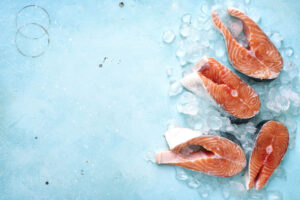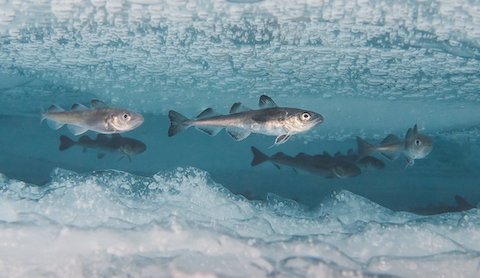Tips on How to Store Fresh Caught Fish: Expert Advice
Catching fish is exciting. But keeping it fresh is essential.
Proper storage ensures the best taste and safety of your catch. Storing fresh caught fish can be tricky if you don’t know the right methods. Fresh fish can spoil quickly if not handled properly. This can lead to wasted efforts and potential health risks.
By learning effective storage techniques, you can enjoy the fruits of your hard work longer. Whether you’re a seasoned angler or a weekend hobbyist, these tips will help you keep your catch in top condition. Ready to make the most of your fresh fish? Let’s dive into the best ways to store your catch and keep it fresh.

Credit: www.greatlakesnow.org
Choosing The Right Storage
Storing fresh caught fish correctly is crucial to maintain its flavor, texture, and nutritional value. The right storage methods can extend the fish’s shelf life, ensuring you enjoy it at its best. Below are some effective strategies for choosing the right storage to keep your fresh catch in prime condition.
Coolers And Ice Packs
One of the most effective ways to store fresh caught fish is using coolers and ice packs. This method is simple and effective, especially if you are still out on the water.
- Use a high-quality cooler with good insulation.
- Place a layer of ice at the bottom of the cooler.
- Lay the fish on top of the ice.
- Cover the fish with more ice packs.
Ensure the cooler is kept in a shady spot to maintain the cold temperature. Regularly check and replace the ice to keep the fish chilled.
Refrigeration Methods
Once you are back home, the refrigerator is the next best storage option. Follow these steps to refrigerate your fish properly:
- Rinse the fish under cold water to remove any dirt or blood.
- Pat the fish dry with paper towels.
- Wrap the fish in plastic wrap or aluminum foil.
- Place the wrapped fish in a shallow pan.
- Store the pan in the coldest part of the refrigerator.
Make sure to use the fish within two days to ensure it stays fresh and tasty. Keeping the fish at a temperature below 40°F will slow down bacterial growth.
:max_bytes(150000):strip_icc()/__opt__aboutcom__coeus__resources__content_migration__serious_eats__seriouseats.com__images__2017__04__20170417-greenpointfishlobsterco-fishonice-vicky-wasik-1-d1b21340d3ab478eb41fd4c95d528cd7.jpg)
Credit: www.seriouseats.com
Preparing Fish For Storage
Storing fresh-caught fish properly ensures that it stays fresh and safe to eat. Proper preparation is key to maintaining the quality of the fish. This section will guide you through the essential steps for preparing your fish for storage, focusing on cleaning, gutting, and filleting.
Cleaning The Fish
Cleaning the fish is the first step in preparing it for storage. Start by rinsing the fish under cold water. This helps remove any surface dirt and slime.
- Rinse the fish thoroughly.
- Use a soft brush to scrub the scales.
- Make sure to clean both sides of the fish.
After rinsing, pat the fish dry with paper towels. Drying the fish helps prevent bacterial growth.
Gutting And Filleting
Gutting the fish removes the internal organs, which can spoil quickly. Use a sharp knife to make a cut along the belly of the fish. Remove the guts and rinse the cavity thoroughly.
- Make a cut from the gills to the tail.
- Remove the internal organs carefully.
- Rinse the cavity with cold water.
Filleting the fish makes it easier to store and cook later. Follow these steps to fillet the fish:
| Step | Instructions |
|---|---|
| 1 | Place the fish on a flat surface. |
| 2 | Make a cut behind the gills. |
| 3 | Run the knife along the backbone. |
| 4 | Remove the fillet from the bones. |
| 5 | Repeat on the other side. |
Once filleted, rinse the fillets under cold water. Pat them dry with paper towels. Store the fillets in airtight containers or vacuum-sealed bags to keep them fresh.
Using Ice For Preservation
Storing fresh caught fish properly is crucial to maintain its quality. Using ice for preservation is one of the best methods to keep your fish fresh. Ice not only keeps the fish cool but also slows down bacterial growth.
Crushed Ice Benefits
Crushed ice has several benefits. It molds around the fish, ensuring even cooling. This helps maintain the fish’s texture and flavor. Crushed ice also melts slowly, keeping the fish cool for a longer time.
Here are some key benefits of using crushed ice:
- Ensures even cooling
- Molds around the fish
- Slows bacterial growth
- Keeps fish fresh longer
Layering Techniques
Proper layering techniques can enhance the preservation of your fish. Follow these steps to layer your fish with ice:
- Place a layer of crushed ice at the bottom of a cooler.
- Lay the fish on top of the ice.
- Cover the fish with another layer of crushed ice.
- Repeat the process if you have more fish.
Using these techniques ensures that your fish stays fresh and cool. Below is a table summarizing the steps:
| Step | Description |
|---|---|
| 1 | Layer crushed ice at the bottom of a cooler |
| 2 | Lay the fish on top of the ice |
| 3 | Cover the fish with another layer of crushed ice |
| 4 | Repeat if you have more fish |
Freezing Fresh Fish
Store fresh caught fish by cleaning and gutting them promptly. Wrap tightly in plastic wrap or foil before freezing. This keeps the fish fresh and prevents freezer burn.
Freezing fresh fish is one of the best ways to preserve it. It retains the flavor and texture for a longer period. Proper techniques ensure the fish remains tasty and safe to eat. Learn the best methods to freeze your fresh catch.Proper Packaging
Proper packaging is crucial for freezing fish. Use airtight containers or heavy-duty freezer bags. Remove as much air as possible to prevent freezer burn. You can also wrap the fish tightly in plastic wrap before placing it in the bag. Label the package with the date and type of fish. This helps you keep track of how long it has been stored.Optimal Freezing Temperatures
The temperature of your freezer plays a key role. Set your freezer to -20 degrees Celsius or lower. This ensures the fish freezes quickly and stays fresh. A rapid freeze reduces ice crystals, which helps maintain texture. Check your freezer’s temperature regularly to ensure it remains consistent. Properly freezing your fresh fish keeps it delicious and safe to eat. Follow these tips for the best results. “`Thawing Fish Safely
Thawing fish correctly is essential for maintaining its flavor and texture. It also prevents harmful bacteria from growing. Follow these tips to ensure your fresh caught fish is safe to eat.
Gradual Thawing
The best way to thaw fish is to do it gradually. Place the frozen fish in the refrigerator. This method keeps the temperature constant and slow. It helps preserve the fish’s quality.
Here is a simple step-by-step process:
- Remove the fish from the freezer.
- Place it in a bowl or on a plate to catch any drips.
- Put the bowl or plate in the refrigerator.
- Let the fish thaw for 12 to 24 hours, depending on the size.
Avoiding Bacterial Growth
Thawing fish at room temperature can cause bacterial growth. This is not safe. Bacteria multiply rapidly between 40°F and 140°F. Always thaw your fish in the refrigerator.
If you need to thaw fish quickly, use cold water. Here is how:
- Place the fish in a sealed plastic bag.
- Fill a bowl with cold water.
- Submerge the bagged fish in the cold water.
- Change the water every 30 minutes to keep it cold.
- The fish should thaw in one to two hours.
Never use warm or hot water. It can cause bacteria to grow. Also, do not refreeze thawed fish. Cook it immediately after thawing.
Long-term Storage Solutions
Storing fresh caught fish for the long term ensures that you enjoy its flavor and nutrients even months later. Whether you’re a fishing enthusiast or have come across a surplus of fresh fish, knowing the best storage methods is essential. Proper storage prevents spoilage and maintains the quality of the fish.
Vacuum Sealing
Vacuum sealing is an effective method to keep your fish fresh for an extended period. By removing the air, you reduce the chances of freezer burn. This process involves placing the fish in a plastic bag and using a vacuum sealer to suck out the air. The airtight environment preserves the fish’s texture and taste. Ensure the fish is dry before sealing to improve the seal.
Canning And Smoking
Canning is another excellent way to store fish long-term. The canning process involves placing fish in jars and heating them to a temperature that kills bacteria. This method allows the fish to be stored at room temperature for years. Always follow proper canning guidelines to ensure safety.
Smoking fish adds a distinct flavor while preserving it. This method involves curing the fish with salt and then smoking it over a fire. The smoke acts as a preservative, allowing the fish to last longer without refrigeration. Smoked fish can be stored in a cool, dry place or frozen for extended shelf life.
Preventing Spoilage
Fresh caught fish can spoil quickly if not stored properly. Preventing spoilage ensures the fish stays fresh and safe to eat. This section covers tips to keep your catch in top condition.
Monitoring Temperature
Temperature control is crucial. Keep the fish on ice to stay cold. The ideal temperature is around 32°F (0°C). Use a cooler with plenty of ice. Check the temperature often. Replace the ice as it melts.
Signs Of Spoilage
Know the signs of spoilage to avoid eating bad fish. Fresh fish should have clear eyes and bright red gills. The skin should be shiny and moist. A strong, unpleasant smell is a bad sign. The flesh should be firm, not mushy. If the fish shows these signs, do not eat it.

Credit: www.fishingvabeach.com
Environmental Considerations
Storing fresh caught fish is not just about preserving taste. It’s also about respecting the environment. By being mindful of sustainable practices and reducing waste, you can ensure that your fishing habits remain eco-friendly. Let’s explore these aspects in detail.
Sustainable Practices
Practicing sustainability means using methods that do not harm the environment. Here are some tips:
- Use biodegradable bags: These bags decompose naturally and do not pollute the waters.
- Catch and release: If the fish is too small or not in season, release it back.
- Follow local fishing regulations: These rules help maintain fish populations.
Reducing Waste
Reducing waste ensures that all parts of the fish are used. Here’s how:
- Use the whole fish: Fillets for meals, bones for stock, and scraps for compost.
- Share with others: If you catch more fish than you need, share with neighbors.
- Proper storage: Store the fish properly to avoid spoilage.
By following these tips, you contribute to a healthier ecosystem. Every small action counts.
Frequently Asked Questions
How To Keep Fish Fresh After Catching?
Immediately clean the fish and keep it cool. Use ice or a cooler to maintain freshness. Store in an airtight container if possible.
Should You Gut A Fish Right Away?
Yes, gutting the fish immediately helps preserve its quality. It prevents bacteria growth and maintains flavor.
Can You Freeze Fresh Caught Fish?
Yes, freezing is a great way to preserve fish. Clean it thoroughly and use vacuum-sealed bags to prevent freezer burn.
How Long Can Fresh Fish Be Stored On Ice?
Fresh fish can be stored on ice for up to 48 hours. Ensure the ice is replenished regularly to maintain freshness.
Conclusion
Storing fresh caught fish properly ensures great taste and safety. Always clean fish promptly. Use ice or refrigeration to keep it fresh. Vacuum sealing can extend storage time. Label and date your fish packages. Freeze fish if not eating soon.
Proper storage prevents spoilage and maintains quality. Enjoy your fresh fish with confidence. Follow these tips for the best results. Happy fishing!



